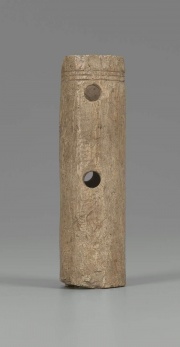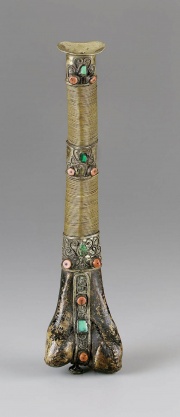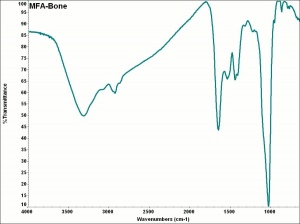Difference between revisions of "Bone"
| (2 intermediate revisions by the same user not shown) | |||
| Line 4: | Line 4: | ||
A white, rigid, calcareous structure that forms the skeleton of vertebrates. Bones have a concentric structure with central lymphatic canals (Haversian canals) surrounded by a spongy lamellar region (marrow) which in turn is protected by a dense outer cortex. The Haversian canals contain nerve tissues and blood vessels. Bones are primarily composed of [[calcium hydroxyapatite]] with smaller amounts of [[calcium carbonate]], [[calcium fluoride]], and [[magnesium phosphate]]. They also contain about 30% [[ossein]], a high molecular weight [[protein]]. Bones have been carved as tools (spear heads, needles, fish-hooks, handles, etc.) and art objects (ornaments, figurines, inlays, bottles, toys, etc.) since ancient times. They are generally whiter, more porous and less dense than [[ivory]]. Bones were also burnt to produce [[bone black]] and boiled to produce [[bone glue]]. | A white, rigid, calcareous structure that forms the skeleton of vertebrates. Bones have a concentric structure with central lymphatic canals (Haversian canals) surrounded by a spongy lamellar region (marrow) which in turn is protected by a dense outer cortex. The Haversian canals contain nerve tissues and blood vessels. Bones are primarily composed of [[calcium hydroxyapatite]] with smaller amounts of [[calcium carbonate]], [[calcium fluoride]], and [[magnesium phosphate]]. They also contain about 30% [[ossein]], a high molecular weight [[protein]]. Bones have been carved as tools (spear heads, needles, fish-hooks, handles, etc.) and art objects (ornaments, figurines, inlays, bottles, toys, etc.) since ancient times. They are generally whiter, more porous and less dense than [[ivory]]. Bones were also burnt to produce [[bone black]] and boiled to produce [[bone glue]]. | ||
[[File:1984.283-SC111340.jpg|thumb|Trumpet<br>MFA # 1984.283]] | [[File:1984.283-SC111340.jpg|thumb|Trumpet<br>MFA # 1984.283]] | ||
| − | + | ||
== Synonyms and Related Terms == | == Synonyms and Related Terms == | ||
| Line 24: | Line 24: | ||
<gallery> | <gallery> | ||
File:graybonekes.jpg|Bone | File:graybonekes.jpg|Bone | ||
| + | File:Illu compact spongy bone.jpg|Bone cross-section from [https://en.wikipedia.org/wiki/Bone Wikipedia] | ||
File:bonesarcomapckes.jpg|Bone sarcoma | File:bonesarcomapckes.jpg|Bone sarcoma | ||
File:humanbone1large.jpg|Bone thin section | File:humanbone1large.jpg|Bone thin section | ||
| Line 29: | Line 30: | ||
== Resources and Citations == | == Resources and Citations == | ||
| − | + | * AIC Wiki Objects Group: [https://www.conservation-wiki.com/wiki/Skeletal_Materials Skeletal Materials] | |
* A.Child, "Microbial Taphonomy of Archaeological Bone" ''Studies in Conservation'', 40:19-30, 1995. | * A.Child, "Microbial Taphonomy of Archaeological Bone" ''Studies in Conservation'', 40:19-30, 1995. | ||
* Gem Identification Lab Manual, Gemological Institute of America, 2016. | * Gem Identification Lab Manual, Gemological Institute of America, 2016. | ||
Latest revision as of 13:45, 5 October 2024
Description
A white, rigid, calcareous structure that forms the skeleton of vertebrates. Bones have a concentric structure with central lymphatic canals (Haversian canals) surrounded by a spongy lamellar region (marrow) which in turn is protected by a dense outer cortex. The Haversian canals contain nerve tissues and blood vessels. Bones are primarily composed of Calcium hydroxyapatite with smaller amounts of Calcium carbonate, Calcium fluoride, and Magnesium phosphate. They also contain about 30% Ossein, a high molecular weight Protein. Bones have been carved as tools (spear heads, needles, fish-hooks, handles, etc.) and art objects (ornaments, figurines, inlays, bottles, toys, etc.) since ancient times. They are generally whiter, more porous and less dense than Ivory. Bones were also burnt to produce Bone black and boiled to produce Bone glue.
Synonyms and Related Terms
os (Fr.); knogle (Dan.); Knochen (Deut.); hueso (Esp.); osso (It., Port.); bot (Ned.); ben (Sven.)
Risks
Sensitive to temperature and humidity changes.
Physical and Chemical Properties
- Bones can be microscopically distinguished from ivory as they are more porous and lack the layered structure; remains of blood vessels appear round or oval in cross-section or as dark spots if filled with dirt
- UV autofluorescence is blue-white with spots
- Mohs Hardness = 2.5
- Density = 1.7-2.0
Additional Images
Bone cross-section from Wikipedia
Resources and Citations
- AIC Wiki Objects Group: Skeletal Materials
- A.Child, "Microbial Taphonomy of Archaeological Bone" Studies in Conservation, 40:19-30, 1995.
- Gem Identification Lab Manual, Gemological Institute of America, 2016.
- J.Thornton,"The Structure of Ivory and Ivory Substitutes", AIC Preprints, Philadelphia, 1981, p.173-181
- The Dictionary of Art, Grove's Dictionaries Inc., New York, 1996 Comment: "Bone" by Frank Minney
- Hermann Kuhn, Conservation and Restoration of Works of Art and Antiquities, Butterworths, London, 1986
- Caring for your Collections, Arthur W Schulz (ed.), Harry N. Abrams, Inc. , New York, 1992
- Tom Rowland, Noel Riley, A-Z Guide to Cleaning, Conserving and Repairing Antiques, Constable and Co., Ltd., London, 1981
- Oppi Untracht, Jewelry Concepts and Technology, Doubleday & Co., Inc., New York City, 1985 Comment: density=2.0
- George Savage, Art and Antique Restorer's Handbook, Rockliff Publishing Corp, London, 1954
- Van Nostrand's Scientific Encyclopedia, Douglas M. Considine (ed.), Van Nostrand Reinhold, New York, 1976
- Random House, Webster's Encyclopedic Unabridged Dictionary of the English Language, Grammercy Book, New York, 1997
- The American Heritage Dictionary or Encarta, via Microsoft Bookshelf 98, Microsoft Corp., 1998
- Wikipedia: Bone (Accessed Sept. 2, 2005 and Dec 2022)
- Art and Architecture Thesaurus Online, https://www.getty.edu/research/tools/vocabulary/aat/, J. Paul Getty Trust, Los Angeles, 2000
- CRC Handbook of Chemistry and Physics, Robert Weast (ed.), CRC Press, Boca Raton, Florida, v. 61, 1980 Comment: density=1.7-2.0






